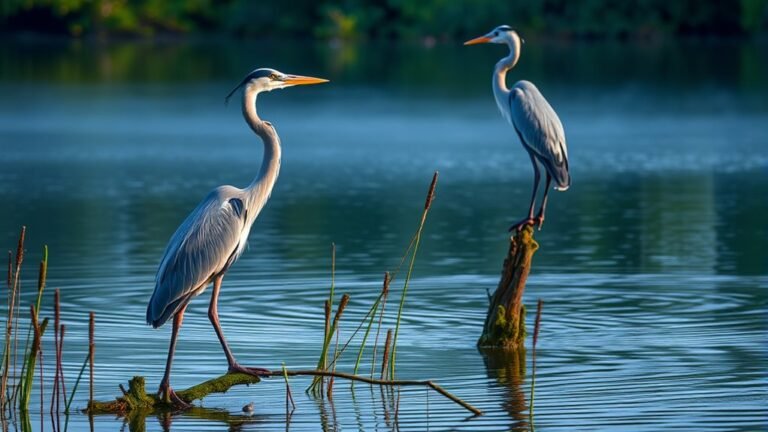Exploring the Symbolism of the Bird of Paradise Plant
The Bird of Paradise plant features vibrant flowers and long leaves. It symbolizes themes of freedom and change. Its bright colors and unique shape catch attention, offering enjoyment to those who see it. Different cultures hold this plant in high regard for its representation of joy, personal identity, and growth. Understanding its meanings enriches our appreciation of nature and human expression. The Bird of Paradise is a beautiful example of nature's creativity and a powerful symbol of hope and transformation.
Key Takeaways
- The Bird of Paradise symbolizes freedom, reflecting personal transformation and the potential for living life without limitations.
- Its vibrant colors are associated with happiness across various cultures, emphasizing a universal connection to joy.
- Historically, the plant has been used in ceremonial decorations, representing paradise and cultural significance in indigenous practices.
- In spiritual contexts, it embodies joy and renewal, encouraging individuals to embrace their authentic selves.
- The Bird of Paradise contributes to biodiversity by attracting pollinators, symbolizing interconnectedness in ecosystems.
The Aesthetic Appeal of the Bird of Paradise

The Bird of Paradise plant (Strelitzia reginae) is a stunning addition to gardens and homes.
It's known for its bright flowers that look like colorful birds. The blooms come in shades of orange and blue, creating a feast for the eyes. Its tall, sword-shaped leaves contrast beautifully with its flowers.
In any space, the Bird of Paradise adds a touch of tropical beauty. Its impressive size draws attention and sparks conversations among garden lovers.
Many people enjoy sharing their admiration for this unique plant, making it a wonderful topic for connection and appreciation.
Historical Significance in Various Cultures
The Bird of Paradise plant is well-known for its vivid appearance and holds cultural significance across various societies. In ancient times, it symbolized paradise and appeared frequently in indigenous art, representing beauty and life.
Different cultures have used this plant in diverse ways, including ceremonial decorations in Polynesia and healing practices in traditional medicines. Each culture added its own meanings, connecting the plant's bright colors to themes of joy and vitality.
For instance, in South Africa, it represents freedom and happiness. By learning about these meanings, you can feel a deeper appreciation for the plant's role in human experiences throughout history.
Symbolism of Freedom and Liberation

Freedom and liberation are significant themes represented by the Bird of Paradise plant. This plant has a vibrant appearance that symbolizes individual freedom, prompting people to consider their own paths to autonomy. Its long leaves and bright flowers express freedom, highlighting the potential for personal change.
In environments that support growth, the Bird of Paradise thrives, showing the value of nurturing one's unique self and goals. Each flower stands tall, undeterred by outside pressures, reinforcing that real liberation comes from accepting one's identity.
Connecting with this plant serves as a reminder of the hope for a life free from limitations.
Representations of Joy and Happiness
The Bird of Paradise plant symbolizes joy and happiness. Its bright flowers represent positive feelings across cultures. The vibrant colors and unique shapes of the flowers can create happiness and encourage good moods.
Studies show that these plants can improve emotional well-being in their environment. In gatherings and social spaces, the Bird of Paradise connects people and reflects shared joy.
Adding this plant to your area not only enhances beauty but also creates a joyful atmosphere for everyone.
The Bird of Paradise in Art and Literature

The Bird of Paradise inspires art and literature in many ways. Its vibrant colors and unique shape draw attention and evoke feelings of beauty and adventure.
Artists portray this plant to capture the essence of exotic nature and wonder. In literature, the Bird of Paradise symbolizes transcendent experiences and the magic of distant lands.
Poets use its qualities to explore freedom and aspiration. By looking at these artistic works and literary pieces, you can see how the Bird of Paradise reflects more than just physical beauty.
It connects to deep human ideas and emotions, making it a meaningful part of our cultural conversation.
Cultural Associations With Paradise and Bliss
The Bird of Paradise plant is known for its striking beauty and vibrant colors. Many cultures associate this plant with paradise and happiness. Its unique shape represents tropical paradises and peaceful getaways.
In ancient Hawaiian culture, people see its blossoms as symbols of joyful connections to the heavens.
African communities regard it as a symbol of freedom and joy.
These cultural meanings show that the Bird of Paradise is more than just a pretty plant. It invites you to explore deeper emotional connections and cultural significance.
The Plant's Role in Traditional Medicine
The Bird of Paradise plant isn't just admired for its beauty; it also has important uses in traditional medicine. This plant contains medicinal properties that are valuable in various remedies. Its leaves and flowers are rich in antioxidants and anti-inflammatory compounds.
These extracts help with respiratory problems and improve skin health. Research shows that they can effectively treat issues like coughs and infections.
Many practitioners use these extracts in holistic practices, highlighting the plant's role in cultural healthcare. By exploring traditional remedies, you connect with a longstanding tradition of natural healing.
This connection fosters a sense of belonging within your community and enriches your understanding of natural health practices.
Connections to Love and Romance
The Bird of Paradise plant symbolizes love and romance in many cultures. Its unique shape resembles a bird in flight, symbolizing freedom and transformation in relationships.
This flower often appears in floral arrangements for weddings and anniversaries, representing passion and devotion. Its bright colors bring joy and excitement, making it a favorite for couples expressing their feelings.
Studies show that these flowers can strengthen emotional bonds, creating a welcoming environment that encourages closeness.
Including the Bird of Paradise in your celebrations enhances your connections, celebrating the beauty of love with a visually stunning symbol.
The Bird of Paradise in Festivals and Celebrations
The Bird of Paradise plant is popular in festivals and celebrations. Its vibrant colors and unique shape attract attention, symbolizing joy and beauty.
Event planners often use it in floral arrangements to create stunning visuals. The plant brings a tropical feel, making it a favorite for summer events.
Including the Bird of Paradise in celebrations enhances the atmosphere, promoting unity and enjoyment. As you attend these gatherings, you'll see how this plant turns ordinary events into memorable occasions filled with cultural meaning and shared happiness.
Spiritual Meanings and Beliefs
The Bird of Paradise plant has strong spiritual meanings in many cultures. It represents freedom, joy, and a sense of paradise. People often view it as a connection between the physical and spiritual worlds.
In spiritual rituals, this plant symbolizes renewal and change, encouraging people to embrace their true selves. Its unique flower shape conveys messages of hope and optimism.
Incorporating the Bird of Paradise into your spiritual practices can strengthen your connection to these meanings. Embracing its significance can lead to a feeling of belonging and promote personal growth, making it a valuable part of your spiritual journey.
Environmental Significance and Conservation
The Bird of Paradise plant is admired for its beautiful appearance. It also plays a vital role in ecosystems, especially in tropical and subtropical areas. This plant attracts birds and insects that help with pollination. This process supports genetic diversity among plants.
Conservation efforts aim to protect the habitats where these plants grow. These environments face threats from deforestation and climate change.
By joining local conservation projects, you help ensure the survival of the Bird of Paradise and its wildlife partners. Supporting local plants boosts biodiversity and strengthens our connection to nature.
These vibrant plants are important in our shared environment.
Gardening and Care: Cultivating Paradise
To grow a healthy Bird of Paradise plant in your garden, follow these clear guidelines:
- Soil Needs: Choose well-draining and nutrient-rich soil. This helps the roots grow strong.
- Watering Routine: Water regularly, but let the top inch of soil dry out before the next watering. This prevents root rot.
- Light Needs: Position the plant in bright, indirect light. It does well in partial sun, but can tolerate full sun.
Also, pay attention to seasonal care. Fertilize during growth periods and prune as needed to keep the plant's shape.
Use pest control methods to protect it from insects. By following these steps, you'll create a beautiful piece of paradise in your garden.
The Bird of Paradise in Modern Design and Decor
The Bird of Paradise plant adds visual interest to modern design and decor. Its unique shape and bold foliage can enhance color schemes in contemporary spaces.
When placed strategically, this plant creates a sense of enclosure and tranquility, acting as a natural focal point.
Using Bird of Paradise designs in textiles can also elevate the overall theme, connecting indoor and outdoor elements.
Whether your style is tropical or minimalist, this plant blends seamlessly with different aesthetics, creating a welcoming atmosphere in your home.
Integrating the Bird of Paradise enhances the beauty of your living space while providing a refreshing touch.
Frequently Asked Questions
What Are the Ideal Growing Conditions for a Bird of Paradise Plant?
To grow well, your bird of paradise plant needs bright, indirect sunlight. Use well-draining soil that is rich in organic matter. Keep the soil consistently moist, but avoid waterlogging. Maintain temperatures between 65-70°F for optimal growth and flowering. This combination of care will help your plant thrive and produce beautiful blooms.
How Often Should I Water My Bird of Paradise Plant?
Water your Bird of Paradise plant every 1 to 2 weeks. Let the soil dry slightly between watering. Although this plant can tolerate drought, regular moisture encourages healthy growth and colorful flowers. This keeps your indoor garden looking vibrant.
Can the Bird of Paradise Plant Thrive Indoors?
Yes, your Bird of Paradise can thrive indoors. Place it in a bright spot with plenty of indirect sunlight. This light is important for its healthy growth and vibrant leaves. With proper care and positioning, your plant will flourish indoors.
What Pests Commonly Affect Bird of Paradise Plants?
Pests like spider mites and aphids often affect Bird of Paradise plants. To protect your plant and help it grow well, use pest prevention methods. Regularly check your plant for pests and apply horticultural oils as needed. This care will keep your Bird of Paradise healthy and vibrant.
Is the Bird of Paradise Plant Toxic to Pets?
The bird of paradise plant is not toxic to pets, which helps keep them safe. However, it is important to watch your pets closely. If they eat any part of the plant, it might lead to stomach issues or allergic reactions. Paying attention to your pets is key for their health.

Hello, I’m Emily Price, the founder of Birds Affection. As a passionate bird enthusiast and spiritual seeker, I’ve always been fascinated by the symbolic meanings and mystical connections between birds and our lives. On this website, I share my knowledge and insights on the spiritual significance of various bird species, exploring their roles as messengers, guides, and teachers. Through my writing, I aim to inspire and educate others on the profound wisdom and beauty that birds bring to our world. Join me on this journey as we delve into the enchanting realm of bird symbolism and discover the hidden meanings behind these magnificent creatures.







